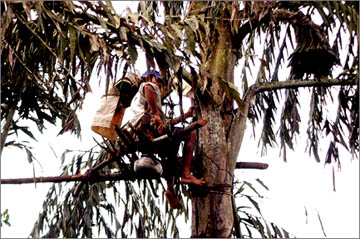|
observer |
|
|
|
|
|
OTHER LINKS |

|

|

|
Shot in the arm for Kithul industryThe Industrial Technology Institute (ITI) scientists have given a new lease of life to the traditional kithul industry that was dying due to the deterioration of traditional technology used in tapping and various other issues that obstruct in scaling up production. ITI scientists have invented modern technology that address all these issues and they are now commercially available.
Kithul (Caryota Urens) also known as fish tail palm or toddy palm, is an indigenous plant, naturally grown in the wild. The kithul industry in Sri Lanka has a history that dates back over 2000 years. It is a unique industry to Sri Lanka because though the Kithul tree is grown in other countries they didn't know the technology to tap the inflorescence and get the sap. Long before sugar came to the market Kithul was the main sweetener in Sri Lanka. It was a cottage industry that produced treacle, jaggery and toddy. With the effluxion of time the industry faced challenges and traditional technology used in tapping deteriorated from generation to generation as people kept the formula a closely guarded secret. As the demand for kithul products is higher people used various chemicals such as carbide and battery acids to tap inflorescence. The success rate of a kithul tree had dropped to 20-30%. Finally the industry was in a crisis and on the verge of dying as the low success rate and lower productivity discouraged people from tapping the trees. The kithul industry was not a commercially viable industry and we faced the challenge of reversing the process, said Dr. Sirimal Premakumara, the head of the research team at the ITI herbal technology division. The objective of the ITI research team was to develop a technology to overcome these issues and make the kithul industry commercially viable. They first studied the traditional tapping technology that was available and used for over thousands of years. "We wanted to get the scientific knowledge in the traditional method and not merely the solution they used. For instance traditionally they used lime to activate sap secretion and then we identified the acid they had been using for the purpose. We used vitamin C for the purpose. We studied all the aspects of the traditional tapping technology such as associated medical mixture and the data related to the sap yield. Finally ITI invented a solution called KASPER or Kithul Activation and Sap Production Enhancing Reagent. KASPER was a highly successful solution to the main issues that the industry faced. When the traditional method was employed in some trees the sap secretion was not activated, but the reasons were unknown, Dr. Premakumara said. However, with KASPER, any Kithul inflorescence can be tapped successfully. Hence the success rate increased 80-100%. Similarly, the sap yield as well as tapping duration increased and with KASPER now a tree can produce nine litres of sap per day and the minimum tapping duration is 90 days. KASPER has the ability to boost the sap secretion if the sap flow decreases or ceases. It can be used even during the rainy season and can be used by a person who doesn't have experience of the traditional tapping method. ITI scientists have invented the technology to address some other issues that prevailed as a bottleneck to the development of the kithul industry. The rapid fermentation quality of kithul sap was one such issue. The ITI introduced a non chemical method to address this issue and now the sap can be preserved up to seven days. This helps to transport the sap from the collecting centres to factories and scale up the industry. This technology will also promote the use of kithul sap as a drink. Extensive research has shown that there is a huge demand for kithul products in the local and international markets because kithul products have unique qualities. Kithul can be used as a substitute for maple syrup in the international market. Kithul is also commercially profitable compared to maple. Eighty-six bottles of sap are needed to produce one bottle of maple syrup. However, to produce one bottle of treacle you need only six bottles of kithul sap. Kithul is a profitable industry that can yield an average Rs. 10,000 per tree per month. The cost of seasoning an inflorescence (using Kasper) is Rs. 50. The average yield of treacle per inflorescence per day is two bottles. However, there are obstacles to developing the kithul industry. There is no formal cultivation of kithul and today the industry depends on naturally grown kithul trees. The National Centre for Kithul Development (NCKD) has drawn up a plan to address these issues. It has proposed to successfully tap 500,000 new kithul trees from the existing trees within the next three years. It has also proposed to grow Kithul in 500h within three years. The NCKD also proposes to start Kithul plantations and set up high tech manufacturing factories as public-private partnerships. ITI has also called upon the SLS for quality standards for kithul products. Today SLS 772 and SLS 521 are used for treacle and jaggery of kithul, palmyrah, coconut and sugarcane. Dr. Premakumar said that for a sustainable development industry it needs strong government support. He has also proposed a Kithul Development Board similar to the coconut and palmyrah development boards. |








